A Midwest Pipeline Rupture Raises Questions About Tar Sands Risk
Canadian company is working overtime to clean up spill, placate community, and get oil flowing again.
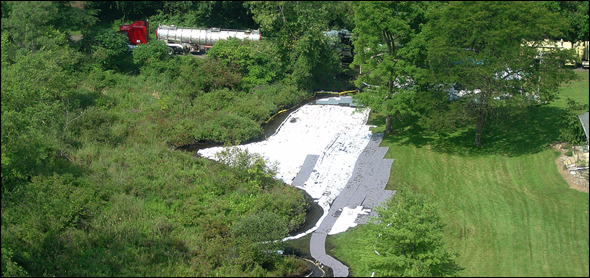
By Steve Kellman
Circle of Blue
A spill of more than 800,000 gallons of oil into a tributary of southern Michigan’s Kalamazoo River is raising larger questions about where the oil came from, why the pipeline carrying the oil ruptured, and the risks to public health and the environment.
Enbridge Inc., Canada’s largest natural gas distribution company, is working with the U.S. Environmental Protection Agency to clean up the spill that was discovered July 26 near Marshall, Michigan. While the company estimated the the spill to be slightly more than 800,000 gallons, the EPA estimated that more than one million gallons may have leaked from the ruptured pipeline. By either measurement, the spill amounts to one of the largest in the history of the Midwest.
On Tuesday, in a separate accident, Federal regulators fined Enbridge Energy Partners more than $2.4 million, the result of a year-long investigation into a 2007 explosion near Clearbrook that killed two people. Regulators found that Enbridge, which operates at least nine oil pipelines in Minnesota, “failed to safely and adequately perform maintenance and repair activities, clear the designated work area from possible sources of ignition, and hire properly trained and qualified workers.”
The Michigan rupture is drawing attention to the Canadian pipeline operator and the opening of a new and very risky era in mining and processing of so-called “unconventional” tar sands and oil shales to provide transportation fuels. The accident occurred 10 days after the Environmental Protection Agency intervened in the State Department’s permit review to construct a separate $7 billion pipeline to carry tar sands oil from Alberta to Oklahoma and the Texas Gulf coast. Enbridge, earlier this year, opened another $3 billion, 1,000-mile tar sands oil pipeline from Alberta to Superior, Wisconsin that is capable of carrying 800,000 barrels per day to Great Lakes refineries that are being retrofitted and expanded to turn tar sands oil into transportation fuels.
A Revealing Gash
The 30-inch-diameter pipeline at the heart of the disaster, known as Line 6B, was being used to transport almost eight million gallons of oil a day from Griffith, Indiana to Sarnia, Ontario. The pipe is part of Enbridge’s 1,900-mile Lakehead System, the U.S. portion of the world’s longest petroleum pipeline and one that serves all the major refining centers in the Great Lakes, Midwest and Ontario, Canada.
More than two-thirds of last year’s western Canadian crude oil exports to the United States were shipped via the Lakehead System, according to Enbridge, with the system transporting 70 million gallons of oil a day.
Recent news briefings on the cleanup efforts illustrate the seriousness with which Enbridge, the EPA, and the news media are taking the spill. A briefing was held on August 12 that featured EPA Regional Administrator Susan Hedman, who oversees the agency’s operations throughout the six-state Great Lakes region, along with Enbridge CEO Patrick Daniel and reporters from the Toronto Star, the Calgary Sun, Reuters and Chicago’s WBEZ public radio station.
Hedman noted that the disaster response has shifted from an emergency phase to keep the oil from leaking into Lake Michigan, to a cleanup phase along a 30-mile stretch of the Kalamazoo River.
“There will be long-term monitoring of the groundwater…and that’s monitoring that will have to go on for literally years,” she said.
Far From Home
Meanwhile Daniel has remained in Michigan—1,850 miles from his corporate offices in Calgary, Alberta—since the day the spill was discovered. The CEO has toured the cleanup area repeatedly, attended news conferences and fielded reporters’ questions and residents’ concerns. More than 1,000 Enbridge employees and contractors work with the EPA on the cleanup. The company has gone so far as to purchase two homes in the area of the spill, and was considering the purchase of six others as of August 16.
Daniel faced more questions August 12 on the source of the oil that spilled, following press reports that it came from Canadian tar sands development. An August 10 article in the Michigan Messenger echoed a previous report by the Natural Resources Defense Council that the line was carrying tar sands oil, mined from thick bitumen in northern Alberta, Canada, the largest reservoir of crude bitumen in the world.
While noting “I’m not a geologist,” Daniel tried to draw a distinction between tar sands oil, or what he referred to as oil sands crude, and what was flowing through the pipeline in Marshall, Michigan.
“As I’ve mentioned on prior calls, this traditionally has not been referred to (as) oil sands crude,” he said. The oil that was flowing through Line 6B was from Cold Lake, Alberta, he said, a region some 200 miles south of the Athabasca region most closely associated with tar sands production.
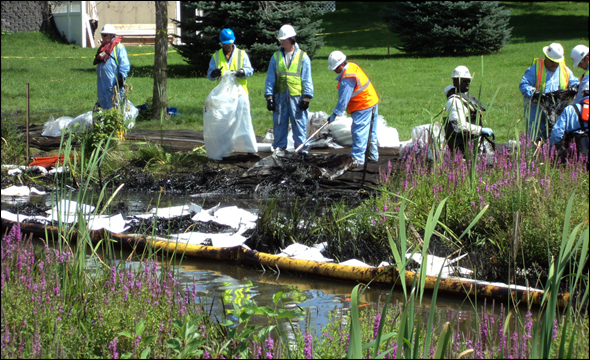
It Is Tar Sands Oil
The Natural Resources Defense Council deconstructed the distinction between Cold Lake and Athabasca oil in an August 13 report. Different methods are used to extract the oil in the two regions—strip-mining deposits is used in Athabasca after leveling the forests that cover them, and injecting steam into the viscous underground oil in Cold Lake to liquefy the oil as well as pump it to the surface. But the product is the same, according to the NRDC—thick bitumen containing sulfur, mercury and other heavy metals that make it more dangerous in a spill as well as more toxic to residents near refinery plants.
Patrick said the source of the oil would not change the approach being used to clean up the spill, a sentiment echoed by Mark Durno, the EPA’s on-scene coordinator for the cleanup.
“The type of oil that was reported is western Canadian crude,” Durno said. “Based on our review of the type of oil and the chemical composition of the oil, we are responding to this no different than we would any other type of crude spill.”
While the July 26 spill was the latest and one of the most severe for Enbridge, several others preceded it.
The Duluth News-Tribune obtained records of dozens of spills from Enbridge-owned pipelines in northern Minnesota over the past 30 years, with some dating back to when the pipelines were owned by Duluth-based Lakehead Pipeline, now an Enbridge subsidiary. All told, nearly 1.5 million gallons of oil have spilled from the pipelines, much into wetlands and some close to the Mississippi River.
Since 2002, Enbridge and its affiliates have faced 30 enforcement actions by the U.S. Department of Transportation’s Pipelines and Hazardous Material Safety Administration (PHMSA), according to the Associated Press.
The Michigan spill has prompted a congressional committee that oversees pipeline regulations to seek eight years worth of information on the pipeline from Enbridge, including information on how the company identifies and monitors leaks as well as records of pipeline maintenance and inspections performed.
Enbridge officials have said they won’t be able to get a more specific figure for the amount of oil spilled until the pipeline that ruptured is placed back into service. That may take some time, as the federal Office of Pipeline Safety rejected Enbridge’s initial plans to repair and restart the line, requesting more inspections of the line first. The company submitted revised plans August 13.
Steve Kellman reports for Circle of Blue from his base in Traverse City, Michigan. Reach him at circleofblue.org/contact.


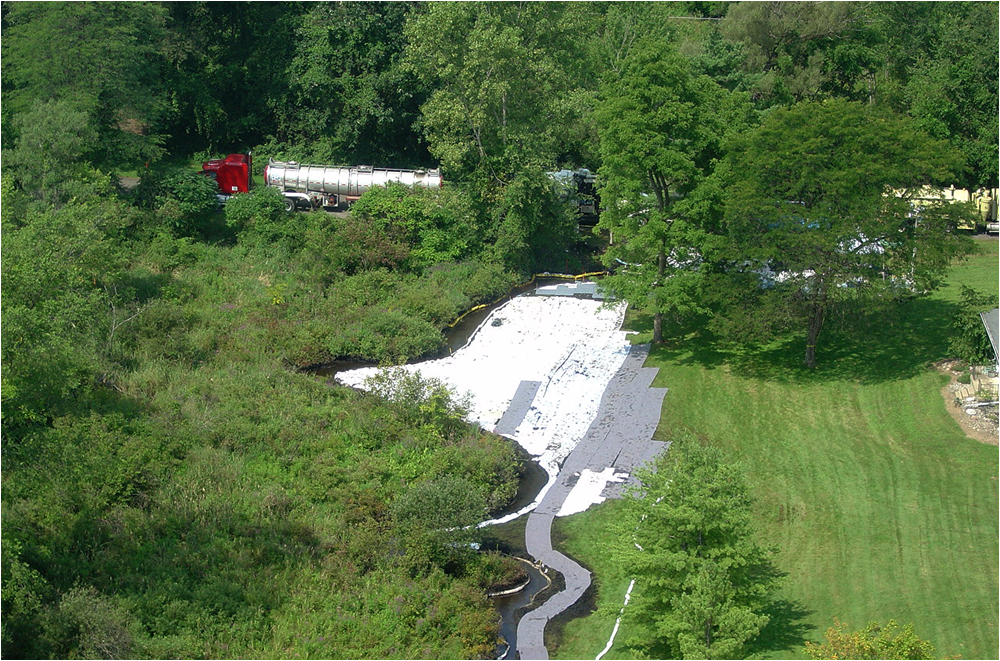
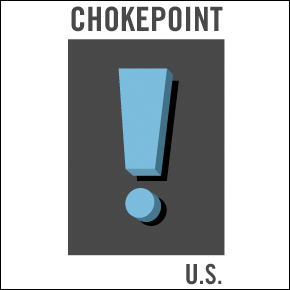

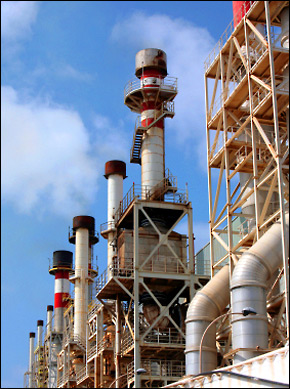

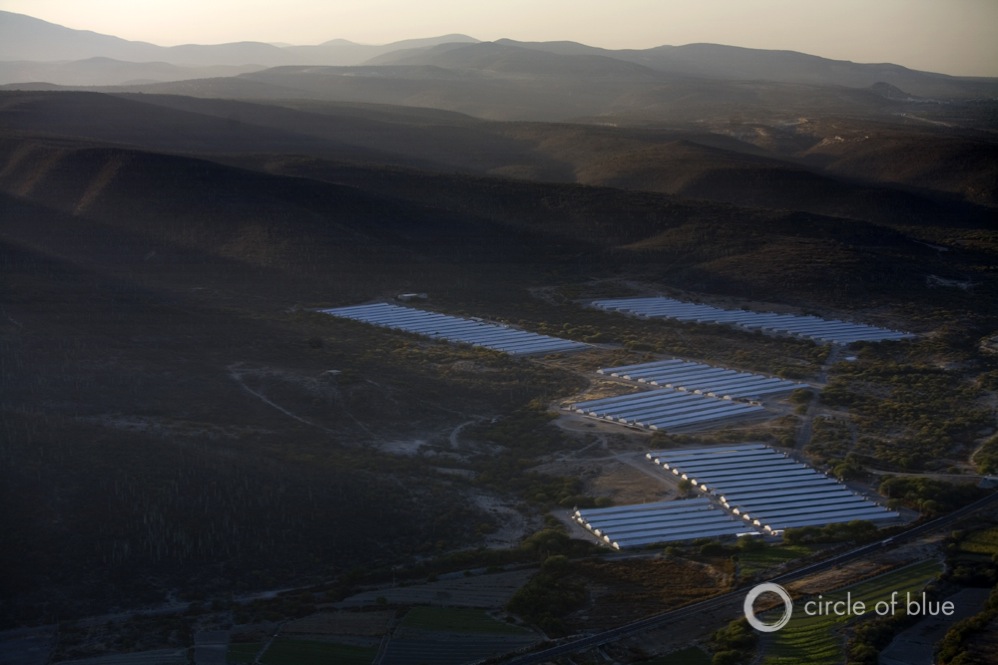
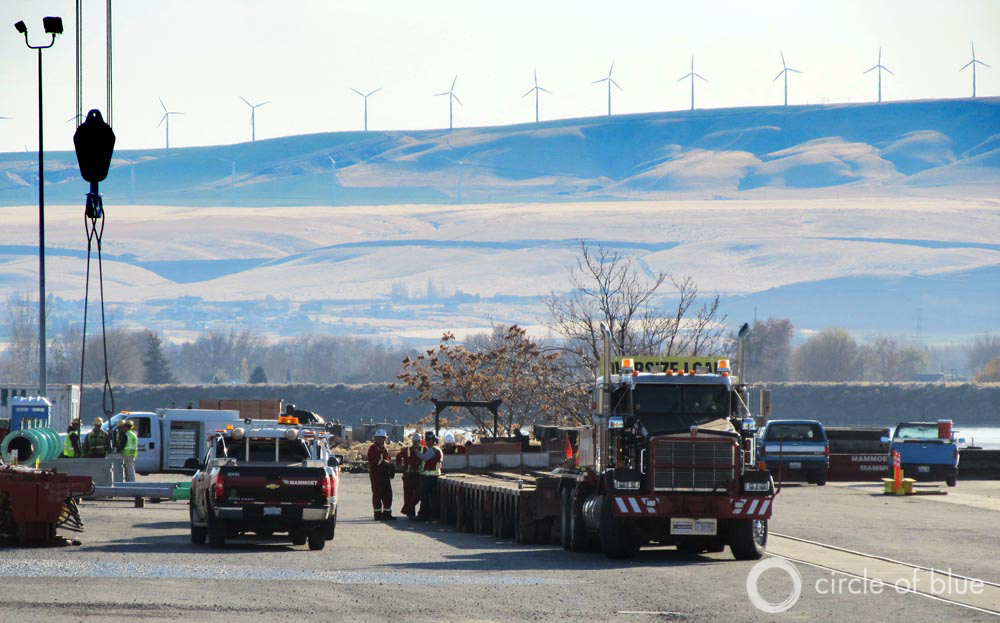


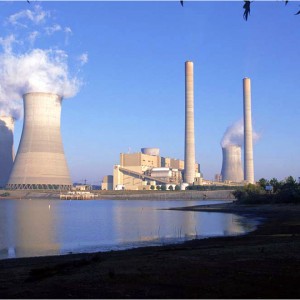
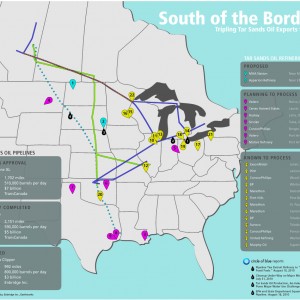
Leave a Reply
Want to join the discussion?Feel free to contribute!